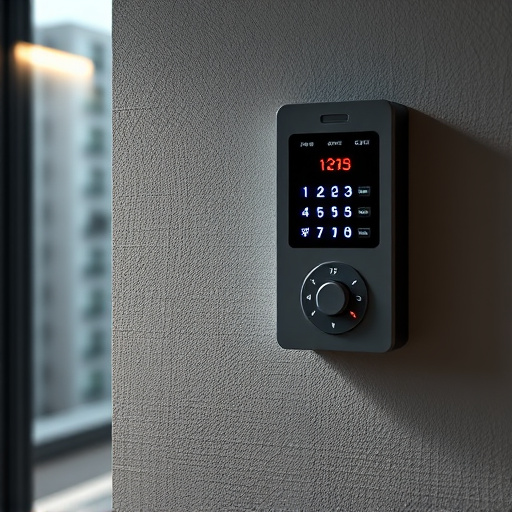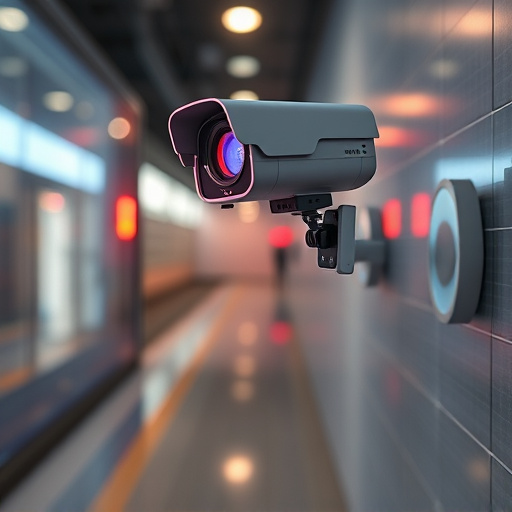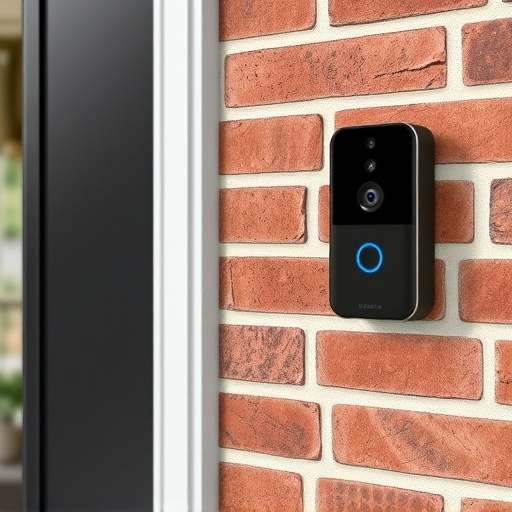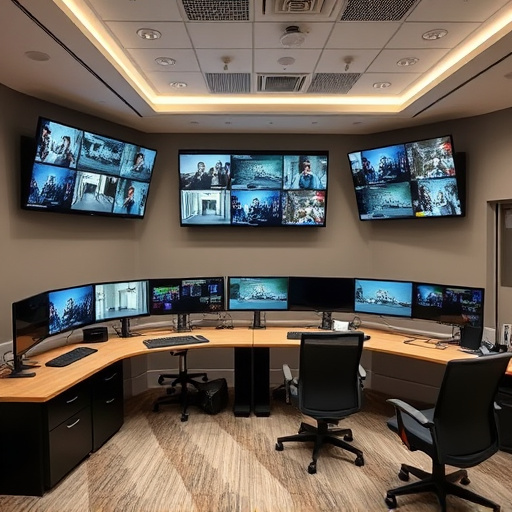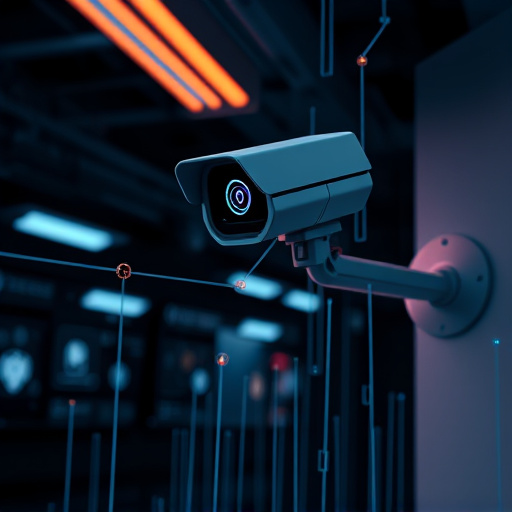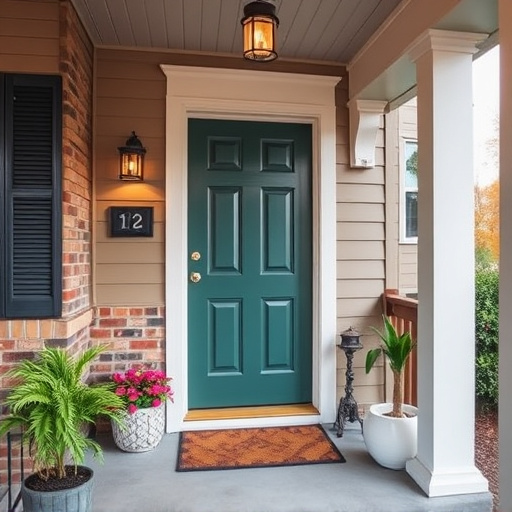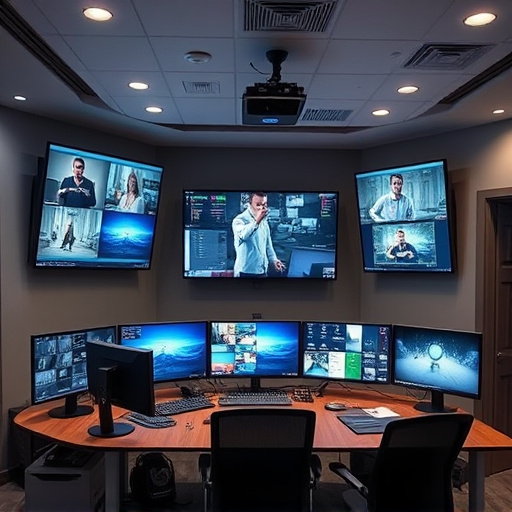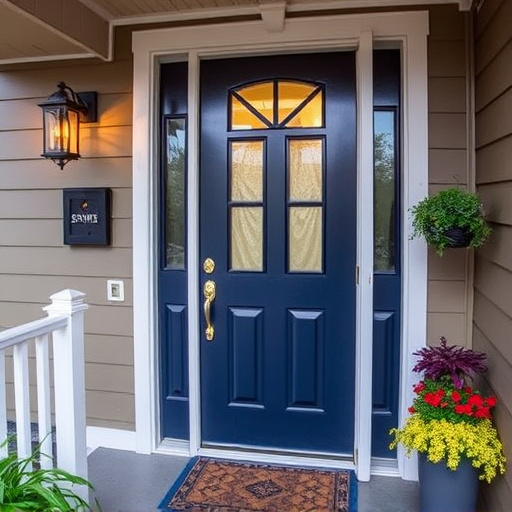
Category: How to Choose the Right Security Camera for Your Home
How to Choose the Right Security Camera for Your Home: A Comprehensive Guide
Introduction
In today’s digital age, home security has evolved beyond traditional locks and alarm systems. The adoption of smart security cameras has become a pivotal component in safeguarding homes and assets. This article delves into the intricate process of selecting the ideal security camera system tailored to individual needs, offering a comprehensive roadmap for homeowners seeking enhanced safety and peace of mind. By exploring various aspects, from technology and regulations to economic factors and real-world applications, readers will gain valuable insights to make informed decisions about their home security setup.
Understanding How to Choose the Right Security Camera for Your Home: A Deep Dive
Definition: The process of choosing a security camera involves evaluating and selecting a system that aligns with specific requirements for monitoring and protecting homes, businesses, or public spaces. It encompasses technical specifications, features, installation considerations, and cost-effectiveness.
Core Components:
- Camera Types: Options include fixed, bullet, dome, PTZ (Pan-Tilt-Zoom), and hidden cameras, each with unique advantages for different applications.
- Resolution: High-definition (HD) and 4K resolutions offer clearer images, crucial for identifying individuals or objects of interest.
- Image Sensor: The type of sensor (e.g., CMOS, CCD) affects image quality, low-light performance, and cost.
- Storage: Cloud storage, local hard drives, or hybrid solutions are essential for recording and retaining video footage.
- Connectivity: Wired or wireless connections determine camera placement and flexibility.
- Features: Motion detection, night vision, two-way audio, and app control enhance functionality and accessibility.
- Installation: Considerations include mounting type, power requirements, and compatibility with existing home automation systems.
Historical Context: The journey towards smarter security cameras began with analog systems in the 1970s, followed by digital advancements in the late 20th century. The early 2000s saw the rise of IP-based cameras, marking a significant shift in performance and functionality. Today, with the Internet of Things (IoT) revolution, security cameras are increasingly integrated into smart home ecosystems, offering remote access, advanced analytics, and improved connectivity.
Significance: Choosing the right security camera is paramount for several reasons:
- Home Safety: It provides real-time monitoring, deterring intruders and enabling swift responses to potential threats.
- Evidence and Surveillance: High-quality footage assists law enforcement in investigations and can serve as compelling evidence.
- Peace of Mind: Remote access features allow homeowners to check on their properties from anywhere, ensuring optimal safety even when away.
- Property Protection: Businesses and commercial spaces benefit from deterring theft, vandalism, and illegal activities.
- Legal Compliance: In many regions, certain types of security cameras are mandated by law for specific premises, especially in high-risk areas.
Global Impact and Trends
International Influence: The global security camera market is a dynamic landscape, influenced by regional variations in technology adoption, economic conditions, and legal frameworks. Key players include China, the United States, and Europe, each contributing unique innovations and trends:
- Asia-Pacific: Known for its tech-savvy markets, this region leads in IP camera penetration and IoT integration. Countries like China produce a significant share of global security cameras, offering competitive pricing and advanced features.
- North America: The US and Canada drive demand for high-resolution, AI-powered analytics, with a focus on privacy regulations.
- Europe: Strict data protection laws, such as GDPR, influence camera design, emphasizing secure data handling and user consent.
Key Trends Shaping the Industry:
- AI and Analytics: Advanced computer vision technologies enable automated object detection, facial recognition, and behavior analysis, enhancing security capabilities.
- Cloud Integration: Cloud-based storage and analytics provide scalable solutions, remote access, and real-time alerts, making camera systems more accessible and manageable.
- Wireless and PoE (Power over Ethernet): Wireless connectivity offers flexibility in camera placement, while Power over Ethernet simplifies installation by transmitting power and data through a single cable.
- Smart Home Integration: Security cameras are increasingly designed to work seamlessly with popular smart home platforms, allowing for centralized control and automation.
- 5G Technology: The rollout of 5G networks enables higher video transmission speeds, supporting advanced camera features like 8K resolution and real-time analytics.
Economic Considerations
Market Dynamics: The security camera market is characterized by intense competition, rapid technological advancements, and diverse pricing strategies:
- Market Size: According to Grand View Research, the global security camera market size was valued at USD 21.8 billion in 2020 and is expected to grow at a CAGR of 13.9% from 2021 to 2028.
- Segmentation: The market includes residential, commercial, industrial, and government/public sector segments, each with distinct demand patterns.
- Pricing Strategies: Cameras range from affordable basic models to high-end systems with advanced features, catering to diverse budgets and requirements.
Investment Patterns: Homeowners and businesses invest in security cameras for various reasons:
- Protection and Peace of Mind: The primary motivation is ensuring safety and preventing losses due to theft, vandalism, or natural disasters.
- Compliance and Legal Requirements: Certain industries and areas have mandatory camera installations for risk management and legal defense.
- Deterrence: High-visibility security cameras can deter potential criminals, reducing the likelihood of unauthorized access.
- Remote Monitoring: Businesses value remote access to surveillance footage, enabling efficient operations and quick responses to incidents.
Role in Economic Systems:
- Job Creation: The industry supports a network of manufacturers, retailers, installers, and maintenance providers, contributing to local economies.
- Innovation and R&D: Continuous technological advancements drive economic growth and foster competition, leading to improved products and services.
- Data Value: With the rise of AI analytics, security camera data is becoming a valuable asset for businesses, enabling predictive analytics and enhanced decision-making.
Technological Advancements
Major Innovations:
- High-Resolution Cameras: The shift from HD to 4K and even 8K resolutions has significantly improved image clarity, allowing for better object recognition and detail capture.
- AI-Powered Analytics: Artificial Intelligence enhances camera capabilities by enabling automated people counting, vehicle license plate recognition, and behavioral anomaly detection.
- Night Vision Improvements: Advanced infrared (IR) technology and enhanced low-light performance ensure clear visibility even in complete darkness, enhancing security during off-peak hours.
- Wireless Connectivity Upgrades: The adoption of Wi-Fi 6 and better communication protocols ensures faster, more reliable wireless connections, reducing lag and interference.
- Cloud Storage Solutions: Cloud-based storage provides scalable, cost-effective options for video retention, enabling remote access and seamless data backup.
Future Potential:
- Edge Computing: Processing analytics closer to the camera source reduces latency and bandwidth requirements, improving real-time performance.
- AR/VR Integration: Augmented Reality (AR) can enhance security by overlaying digital information on live footage, while Virtual Reality (VR) offers immersive training simulations for security personnel.
- Quantum Technology: Future advancements may include quantum sensors for improved image stabilization and low-light performance, revolutionizing camera technology.
- Biometric Authentication: Integrating biometric data into security systems can provide multi-factor authentication, enhancing privacy and access control.
Policy and Regulation
Key Policies and Frameworks:
- GDPR (General Data Protection Regulation): In the EU, GDPR imposes stringent rules on data collection, processing, and storage, impacting camera manufacturers’ design and marketing strategies.
- CCPA (California Consumer Privacy Act): Similar to GDPR, CCPA grants California residents enhanced privacy rights regarding their personal data, including security camera footage.
- National Data Protection Laws: Many countries have implemented data protection acts, dictating how security camera data can be collected, stored, and shared.
- Industry-Specific Regulations: Certain industries, such as healthcare and finance, have unique regulatory requirements for surveillance systems to protect sensitive information.
Influences on Security Camera Development:
- Data Privacy Concerns: Regulatory bodies are driving the development of more privacy-focused camera technologies, emphasizing user consent, data encryption, and secure storage practices.
- Performance Standards: Governments often set standards for camera performance, including image quality, field of view, and low-light sensitivity, ensuring consistent surveillance capabilities across different systems.
- Ethical Considerations: Discussions around bias in AI algorithms and the responsible use of facial recognition technology have led to guidelines and audits to ensure fair and unbiased security practices.
Challenges and Criticisms
Common Issues:
- Privacy Concerns: The widespread adoption of security cameras raises privacy issues, especially with advanced analytics and remote access capabilities. Balancing public safety and individual privacy remains a significant challenge.
- Camera Spams: In some areas, excessive camera installations can create ‘camera spam,’ making it difficult to identify relevant footage during investigations.
- False Positives/Negatives: AI-powered analytics may produce inaccurate results due to data biases or poor training, leading to false alarms or missed incidents.
- Cybersecurity Risks: As cameras become more connected, they introduce potential entry points for hackers, requiring robust cybersecurity measures to protect sensitive data.
Proposed Solutions:
- Transparent Data Handling: Camera manufacturers should implement clear data collection and usage policies, ensuring user consent and providing control over personal information.
- Industry Standards for Ethics: Developing ethical guidelines and certifications for security camera technology can ensure responsible data handling and bias mitigation.
- Enhanced Cybersecurity Measures: Implementing end-to-end encryption, secure communication protocols, and regular software updates are crucial to protect cameras from cyber threats.
- Data Retention Policies: Defining appropriate data retention periods and securely disposing of old footage helps maintain a balance between surveillance and privacy.
Case Studies: Real-World Applications
Case Study 1: Smart City Surveillance in Singapore
Singapore’s “Smart Nation” initiative includes an extensive network of security cameras integrated into a centralized surveillance system. High-resolution cameras with AI analytics monitor traffic flow, detect unusual behavior, and assist in public safety incidents. The government’s data-driven approach enhances efficiency but raises privacy concerns among residents.
Lessons Learned:
- Comprehensive urban surveillance can significantly improve public safety and traffic management.
- Balancing advanced technology with robust data protection measures is essential to gaining public trust.
- Centralized systems offer benefits in real-time data analysis, but they become critical infrastructure targets, requiring enhanced cybersecurity.
Case Study 2: School Safety System in the USA
Many US schools have implemented security camera systems with facial recognition technology to ensure student safety and prevent unauthorized access. The system alerts staff about potential threats and enables quick responses during emergencies. However, concerns over false positives and data privacy sparked debates and regulatory interventions.
Key Takeaways:
- Facial recognition technology can enhance school security but requires careful implementation to avoid discrimination and false identification.
- Privacy regulations and public discourse are essential in shaping the responsible use of advanced camera technologies in sensitive environments.
- Regular system audits and updates are necessary to address technical inaccuracies and keep up with evolving security threats.
Case Study 3: Remote Monitoring for Businesses
A global e-commerce company adopted a remote monitoring solution, allowing employees to access live surveillance feeds from anywhere. This enabled efficient operations, faster incident response, and cost savings on physical security staff. However, the setup required stringent cybersecurity measures to protect sensitive customer data.
Insights:
- Remote access features significantly enhance business operational flexibility and cost efficiency.
- Robust cybersecurity is paramount when implementing cloud-connected security cameras to safeguard sensitive information.
- Employee training and clear use policies are crucial for maximizing the benefits of remote monitoring while ensuring responsible data handling.
Future Prospects: Emerging Trends and Strategic Considerations
Potential Growth Areas:
- Smart Home Integration: As smart home ecosystems mature, security cameras will become seamless components, offering centralized control, automation, and enhanced user experiences.
- AI-Driven Insights: Advanced analytics will provide deeper insights into security trends, enabling proactive risk management and predictive maintenance.
- 5G and Edge Computing: The rollout of 5G networks and edge computing will enable real-time camera analytics, even in remote locations, opening doors for innovative use cases.
Emerging Trends to Watch:
- AI-Generated Video Content: AI can create synthetic video content, offering new possibilities for training simulations and virtual security scenarios.
- Behavioral Analytics: Analyzing camera footage to understand human behavior patterns can lead to improved security protocols and enhanced customer experiences in public spaces.
- Blockchain Integration: Blockchain technology can enhance data security and privacy by providing secure, tamper-proof logs of surveillance events.
Strategic Considerations for Homeowners and Businesses:
- Future-Proofing: Investing in scalable and upgradable systems ensures longevity and adaptability to emerging technologies.
- Regular Updates and Audits: Keeping camera software and analytics up to date reduces vulnerabilities and improves performance, especially with AI-powered systems.
- Collaborative Security: Partnering with local law enforcement or community watch programs can enhance surveillance capabilities and foster a safer environment.
Conclusion: Securing Your World with Smart Cameras
Choosing the right security camera is not merely about selecting a device; it involves creating a comprehensive safety network tailored to individual needs. As technology advances, cameras become smarter, more connected, and capable of transforming home security into an efficient, proactive force. From high-resolution footage to AI analytics and remote access, each feature contributes to a safer, more informed environment.
The global impact of smart security cameras is evident in their rapid adoption across diverse sectors, from residential homes to bustling cities. As regulations evolve, manufacturers must navigate data privacy concerns while delivering innovative solutions. By embracing technology responsibly and staying informed about the latest advancements, homeowners and businesses can secure their properties with confidence, knowing they have the best tools available to protect what matters most.
FAQ Section: Addressing Common Queries
Q1: How do I know if a security camera is any good?
A good security camera should offer clear, high-resolution footage, reliable connectivity (Wi-Fi or Ethernet), advanced features like motion detection and night vision, and easy mobile access. User reviews, industry comparisons, and independent testing reports can help gauge a camera’s performance.
Q2: Are security cameras a privacy invasion?
Security cameras are tools designed to enhance public safety and protect private properties. While they capture data, responsible use involves obtaining consent, ensuring data encryption, and adhering to local laws. Users should balance the benefits of enhanced security with potential privacy concerns.
Q3: Can AI analytics be accurate in detecting threats?
AI-powered analytics are continually improving but are not infallible. Regular training, diverse data sets, and human oversight help mitigate biases and inaccuracies. It’s essential to stay updated on camera software versions and consult professionals for complex setup scenarios.
Q4: How can I protect my security camera footage from hackers?
Implementing strong encryption protocols (HTTPS/TLS), keeping firmware up to date, using secure passwords, and enabling two-factor authentication significantly enhances camera security. Regularly audit network connections and consider professional cybersecurity consultations.
Q5: What should I look for when installing a security camera outside?
Outdoor cameras require weatherproof housing, enhanced night vision capabilities, and wider fields of view. Consider mounting options, such as walls or poles, and ensure the camera faces areas needing surveillance. Regular cleaning and maintenance are essential to maintain optimal performance.

